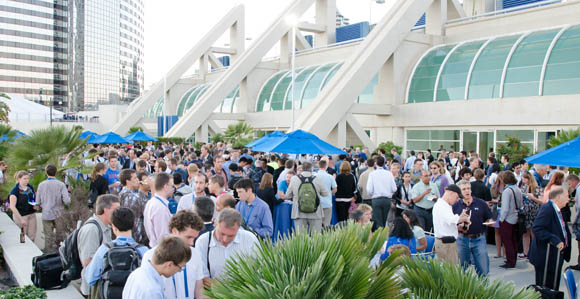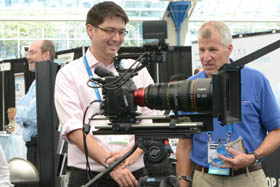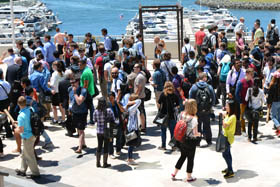Topics include paradigm-changing LIGO, new Mars images, and new tools for climate change monitoring, energy generation
 |
| Optics and photonics researchers, engineers, program managers, and product developers from around the world will return to the San Diego Convention Center in August for SPIE Optics + Photonics 2016; above, the welcome reception during last year's event. |
BELLINGHAM, Washington, USA -- Astrophysics' new LIGO-enabled paradigm for exploring the universe, the latest findings of the Mars rovers, and bioinspired robotics are just a few topics in optical engineering to be featured at SPIE Optics + Photonics in August.
More than 3,000 reports on the latest in research and applications development are on the program for the weeklong event at the San Diego, California, Convention Center, running 28 August through 1 September.
 |
| Audience members respond to a plenary speaker during SPIE Optics + Photonics 2015. |
A few of the featured speakers are:
 |
| The three-day exhibition showcases the latest from industry systems and applications developers. |
SPIE 2016 Gold Medal winner Paras Prasad, University at Buffalo, State University of New York, will give the first of three talks in a symposium-wide plenary session on Sunday evening. Prasad will tell how applications from brain research to solar-energy conversion to security encoding can be advanced via photon management through in situ photon conversion with optical nanotransformers.
Mars Curiosity Rover scientist Melissa Rice of Western Washington University in her plenary talk will show the latest images from Curiosity as well as the Opportunity Rover, and discuss instrumentation in use now and plans for future imaging science in the next rover, to be launched in 2020.
Michael Tolley, University of California, San Diego, in the third plenary talk on Sunday will describe work in the university's Bioinspired Robotics and Design Lab in robotic systems including soft robots and systems that self-assemble, and hold potential to address problems in healthcare, manufacturing, and disaster relief.
 |
| Students find much of interest, with the SPIE Optics + Photonics student leadership workshop and numerous other events. |
SPIE Optics + Photonics also offers a three-day free-admission exhibition, industry sessions on commercialization, smart cities, and other topics, an extensive suite of professional development courses in fundamental and advanced technologies, and numerous networking opportunities.
New conferences among the total of 65 in the event's four symposia -- Nanoscience + Engineering, Optics + Photonics for Sustainable Energy, Organic Photonics + Electronics, and Optical Engineering + Applications -- cover:
More details including registration information are on the event website.
About SPIE
SPIE is the international society for optics and photonics, an educational not-for-profit organization founded in 1955 to advance light-based science, engineering, and technology. The Society serves nearly 264,000 constituents from approximately 166 countries, offering conferences and their published proceedings, continuing education, books, journals, and the SPIE Digital Library. In 2015, SPIE provided more than $5.2 million in support of education and outreach programs. www.spie.org
Contact:
Amy Nelson
Public Relations Manager
amy@spie.org
+1 360 685 5478
@SPIEtweets
All photos © SPIE, the international society for optics and photonics, except where noted.